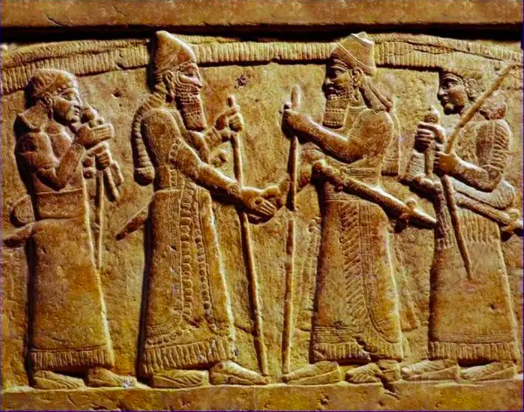Happy New Year, or is it?

Did you know that historically, the 1st Jan wasn’t widely recognised as the first day of the new year?
To explain, we have to go back in time…
The Babylonians, an ancient civilisation that thrived in Mesopotamia, from the 18th century BCE to the 6th century BCE, in the region that is now modern day Iraq, established one of the earliest known forms of a calendar, known as the Babylonian calendar. Their calendar was primarily lunar-based, with months calculated based on the phases of the moon. The Babylonians observed the lunar cycles and developed a system where each month began with the first sighting of the new visible crescent moon.
A lunar month is approximately 29.5 days, and a year comprises 12 lunar months. However, a purely lunar calendar does not align precisely with the solar year, leading to a mismatch between the calendar and the seasons.
To reconcile the lunar months with the solar year, the Babylonians incorporated intercalation, which involved adding an extra month periodically. While this practice helped maintain rough synchronisation, it was not as accurate as later calendar systems.
The Babylonians also did not explicitly account for the fractional days in a lunar month. In reality, a lunar month is not exactly 29.5 days, and the failure to include fractional days in the calculations contributed to discrepancies over time.
Now the Babylonians are usually inaccurately credited for being the first to establish that the new year starts in March but technically they didn’t. In fact, they associated the beginning of the agricultural year with the spring equinox, which typically falls around March 20th or 21st. This connection to the equinox is related to the importance of the changing seasons for agricultural activities.
The direct association of the new year with March is not explicitly documented in Babylonian texts. The celebration of the new year around the spring equinox is more commonly associated with other ancient civilizations, such as the Romans, who celebrated the new year in late March as part of their earlier calendar systems.
The ancient Roman calendar, known as the Julian calendar, originally had the new year beginning in March to coincide with the vernal equinox.
Introduced by Julius Caesar in 45 BCE, the modified calendar aimed to reform the archetypal Roman calendar and bring it in line with the solar year. While the Julian calendar was an improvement over earlier Roman calendars, it still had inaccuracies that accumulated over time due to its method of accounting for leap years. The key inaccuracy was related to the length of the solar year.
The Julian calendar incorporated a leap year system where an extra day was added to the calendar every four years. This was intended to account for the roughly 365.25 days in a solar year. However, the actual length of a solar year is approximately 365.242 days. The discrepancy between the Julian calendar's approximation and the actual solar year resulted in a gradual misalignment of the calendar with the seasons.
As part of these reforms, January 1st was established as the first day of the year. The choice of January 1st was not based on a specific astronomical event but was likely influenced by various factors, including the desire to align the calendar with the consular year and to honour the god Janus, the deity of beginnings and transitions.
This calendar laid the foundation for subsequent calendar systems, including the Gregorian calendar, which is the calendar widely used today. The Gregorian calendar, introduced by Pope Gregory XIII in 1582, retained January 1st as the beginning of the year and made further adjustments to improve accuracy in tracking the solar year.
The Julian calendar was about 10 days ahead of the solar year. To address this issue, the Gregorian calendar introduced adjustments to the leap year rule. While still a leap year every four years, years divisible by 100 would not be leap years unless they were also divisible by 400. This refined rule more accurately approximated the length of the solar year and corrected the cumulative errors that had built up under the Julian calendar.
The transition from the Julian to the Gregorian calendar involved the removal of the accumulated discrepancy by skipping several days in October 1582. The Gregorian calendar is the calendar system widely used today and is arguably more accurate in synchronising with the Earth's orbit around the sun.
The choice of January 1st as the start of the new year in the Gregorian calendar is a combination of historical, cultural, and religious considerations rather than one based on science. While the Gregorian calendar aimed to address astronomical inaccuracies present in earlier calendar systems, sticking with Julien Calendar’s decision to shift the beginning of the year from March to Jan 1st was influenced by various factors:
The Solemnity of Mary: January 1st is the Feast of the Solemnity of Mary, Mother of God, in the Christian liturgical calendar. By aligning the start of the new year with a religious feast day, Pope Gregory XIII sought to integrate the calendar with Christian traditions.
Symbolism of New Beginnings: January 1st carries symbolic significance as the beginning of a new year and a fresh start. While not tied to any specific astronomical event, it aligns with the concept of new beginnings, resolutions, and the start of a cycle.
Consistency with the Roman Calendar: The Roman calendar tradition, which influenced both the Julian and Gregorian calendars, had already designated January as the first month. This continuity contributed to the preservation of January as the start of the year.
While the Gregorian calendar aimed to bring the calendar year into closer alignment with the solar year, the specific date chosen for the start of the year was influenced by historical and cultural factors. The Gregorian calendar, with January 1st as the beginning of the year, became widely adopted globally over time and is now the most widely used calendar system.
No posts found
Write a review